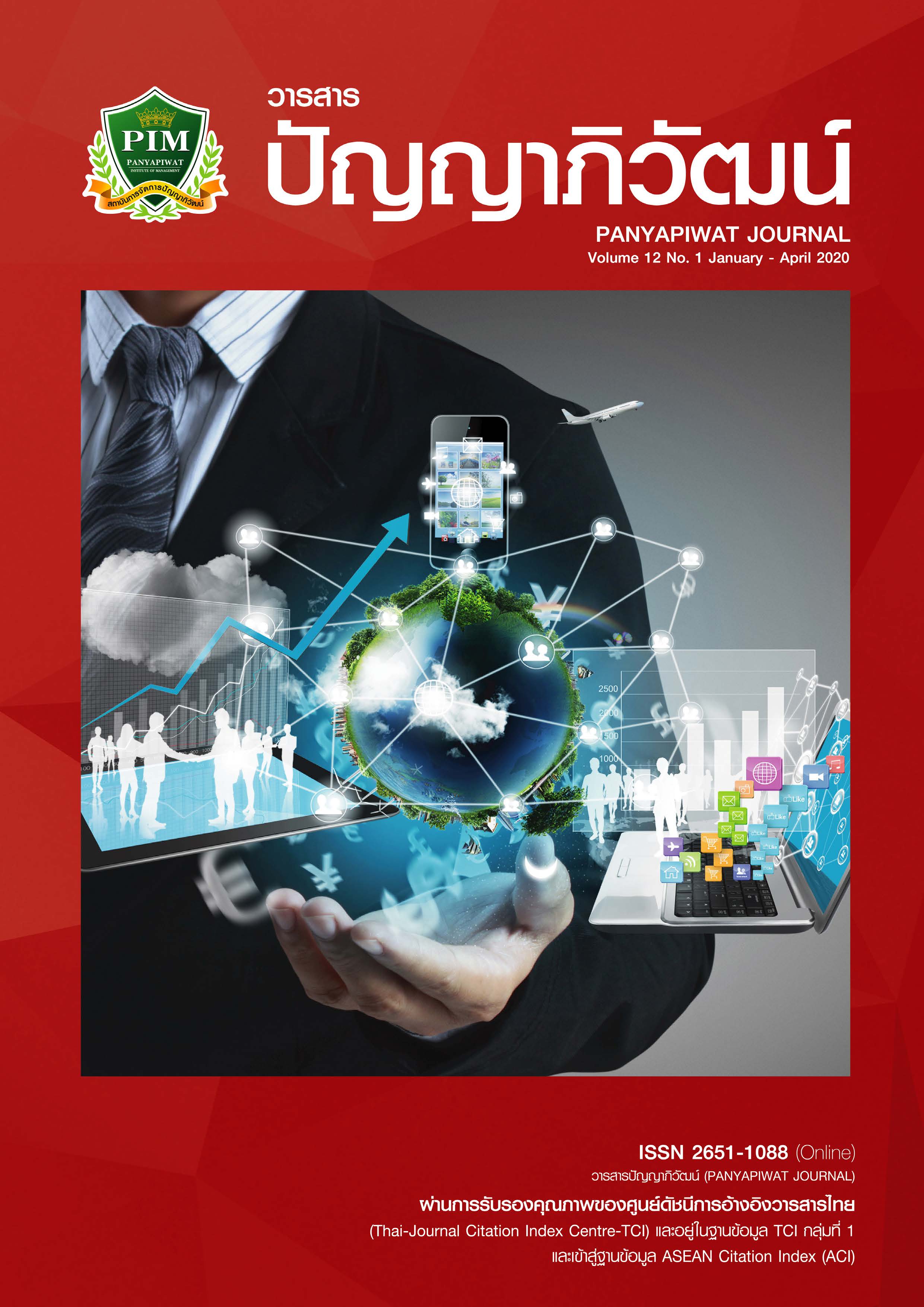รูปแบบการจัดการการตลาดท่องเที่ยวอาเซียนอย่างมีความได้เปรียบตามการรับรู้ของนักท่องเที่ยวไทยระดับบน
Main Article Content
บทคัดย่อ
การวิจัยครั้งนี้มีวัตถุประสงค์เพื่อมุ่งพัฒนารูปแบบการจัดการการตลาดท่องเที่ยวอาเซียนอย่างมีความได้เปรียบตามการรับรู้ของนักท่องเที่ยวไทยระดับบน เครื่องมือที่ใช้ในการวิจัยคือ แบบสอบถาม (Questionnaire) ที่มีความตรงเชิงเนื้อหาผ่านเกณฑ์ 0.50 ขึ้นไป และความเชื่อมั่นตั้งแต่ 0.70 ขึ้นไป วิเคราะห์องค์ประกอบ เชิงยืนยันอันดับสอง ผลการวิจัยพบว่า รูปแบบการจัดการการตลาดท่องเที่ยวอาเซียนอย่างมีความได้เปรียบที่พัฒนาขึ้นมีความกลมกลืนกับข้อมูลเชิงประจักษ์ทั้งหมด 22 ตัวชี้วัด จาก 5 องค์ประกอบ ยกเว้นองค์ประกอบที่ 2 การต่อรองของนักท่องเที่ยว กรณีความสามารถของผู้ซื้อที่มีการรวมกิจการไปด้านหลัง (Factor Loading = 0.327) โดยแต่ละองค์ประกอบต่างมีความเที่ยงตรงเชิงเหมือน เนื่องจากค่าความเชื่อมั่นเชิงโครงสร้างผ่านเกณฑ์มากกว่า 0.60 และค่าน้ำหนักองค์ประกอบผ่านเกณฑ์ 0.40 ขึ้นไปด้วย
Article Details
“ข้าพเจ้าและผู้เขียนร่วม (ถ้ามี) ขอรับรองว่า บทความที่เสนอมานี้ยังไม่เคยได้รับการตีพิมพ์และไม่ได้อยู่ระหว่างกระบวนการพิจารณาลงตีพิมพ์ในวารสารหรือแหล่งเผยแพร่อื่นใด ข้าพเจ้าและผู้เขียนร่วมยอมรับหลักเกณฑ์การพิจารณาต้นฉบับ ทั้งยินยอมให้กองบรรณาธิการมีสิทธิ์พิจารณาและตรวจแก้ต้นฉบับได้ตามที่เห็นสมควร พร้อมนี้ขอมอบลิขสิทธิ์บทความที่ได้รับการตีพิมพ์ให้แก่สถาบันการจัดการปัญญาภิวัฒน์หากมีการฟ้องร้องเรื่องการละเมิดลิขสิทธิ์เกี่ยวกับภาพ กราฟ ข้อความส่วนใดส่วนหนึ่งและ/หรือข้อคิดเห็นที่ปรากฏในบทความข้าพเจ้าและผู้เขียนร่วมยินยอมรับผิดชอบแต่เพียงฝ่ายเดียว”
เอกสารอ้างอิง
Borsekova, K., Vanova, A. & Vitalisova, K. (2016). Smart specialization for smart spatial development: Innovative strategies for building competitive advantages in tourism in slovakia. Socio Economic Planning Sciences journal, 12, 61-79.
Byrne, B. M. (2011). Structural equation modeling with Mplus. New York: Routledge.
Camison, C., PuigDenia, A., Fores, B., Eugenia, F. M., Munoz, A. & Munoz, M. C. (2016). The importance of internal resources and capabilities and destination resources to explain firm competitive position in the Spanish tourism industry. International Journal of Tourism Research, 18(4), 341-356.
Carlson, J. & Rosenberger, P. J. (2016). A hierarchical model of perceived value of group-oriented travel experiences to major events and its influences of satisfaction and future group-travel intentions. Journal of Travel & Tourism Marketing, 33(9), 1251-1267.
Chee, H. L. (2007). Medical tourism in Malaysia: International movement of healthcare consumers and the commodification of healthcare. Asia Research Institute Working, 83, 32.
Choonhavejsakul, A. (2017). The Affect of Creative Marketing and Content Advertising Strategy of Spending Behavior of Chinese, Japanese, South Korean Tourists’ Generation Y. Bangkok: Doctor of Business Administration, Marketing, Siam University. [in Thai]
Cirstea, S. D. (2014). Travel & tourism competitiviness: A study of world’s economic competitiviness countries. Procedia Economics and Finance, 15, 1273-1280.
Cochran, W. G. (2011). Sampling techniques (3rded.). New York: John Wiley & Sons.
Cronbach, L. J. (2003). Essential of psychology testing. New York: Hanpercollishes.
Department of Tourism. (2013). ASEAN tourism strategy plan 2011-2015. Department of Tourism, Ministry of Tourism & Sports, 1-10. [in Thai]
Esteghamati, A., Zandieh, A., Khalilzadeh, O., Meysamie, A. & Ashraf, H. (2010). Clustering ofmetabolic syndrome components in a Middle Easterndiabetic and non-diabeticpopulation. DiabetolMetab Syndrome. Retrieved February, 21, 2018, from https://www.ncbi.nlm. nih.gov/pmc/articles/PMC2897775/
Fehr, E. & Falk, A. (1999). Wage rigidity in a competitive incomplete contract market. Journal of Political Economy, 10, 106-134.
Forsyth, T. J. (1995). Tourism and agricultural development in Thailand. Annals of Tourism Research, 22(4), 877-900.
Hair, J. F., Black, W. C., Babin, B. J. & Anderson, R. E. (2010). Multivariate data analysis (7th ed.). New Jersey: Upper saddle River, Pearson Education International.
Hatcher, L. (2013). A step-by-step approach to using the SAS system for factor analysis andstructural equation modeling (2nd ed.). Cary, NC: SAS Institute.
Joppe, M. & Choi, H. S. C. (2010). The evolution of attitudes towards spa holidays in Canada. In Proceedings of the travel and tourism research association. (pp.76-85). Europa annual conference Hungary: Travel and Tourism Association.
Kelloway, E. K. (2015). Using Mplus for structural equation modeling: A researcher’s guide (2nd ed.). London: SAGE.
Kline, R. B. (2015). Principles and practice of structural equation modeling (4th ed.). New York: Guilford Publication.
Murthy, U., Anthony, P. & Perumal Gopal, M. (2016). The Behaviors of Generation Y Tourists from Asean Countries towards Malaysian Tourism Industry in Kuala Lumpur, Malaysia, International Journal of Business and Management, 11(12), 249-260.
Online Manager (2017). TAT. Persuasion of Thai entrepreneur urging for European Thailand market in ITB 2017 event in Berlin, Germany. Retrieved February, 21, 2018, from https://www.manager.co.th/Travel/ViewNews.aspx?NewsID=9600000024708 [in Thai]
Online Prachachat Business. (2016). New Debut ASEAN Logo Visit ASEAN@50 and ASEAN boomingtourism campaign. Retrieved February, 21, 2018, from https://www.prachachat.net/news_ detail.php?newsid=1473300016 [in Thai]
Online Thairath. (2016). Thailand as center of all over the world tourist attraction to ASEAN. Retrieved February, 21, 2018, from https://www.thairath.co.th/content/589196 [in Thai]
Otilia, D. A. & Loana, C. P. C. (2016). Competitiveness in the tourism sector: The case of Romania. Annals of Faculty of Economics, University of Oradea, Faculty of Economics, 1(2), 182-193.
Porter, M. E. (2011). Competitive advantage of nations: Creating and sustaining superior performance. New York: The Free Press.
Posttoday Newspaper. (2016). ASEAN nations announce travel campaign. Retrieved February, 21, 2018, from https://www.posttoday.com/biz/aec/news/453194 [in Thai]
Richard, J. E. & Zhang, A. (2012). Corporate image, loyalty, and commitment in the consumertravel industry. Journal of Marketing Management, 28(5-6), 568-593.
Singh, N. & Gill, H. (2011). Exploring the factors that affect the choice of destination for medical tourism. Journal of Service Science and management, 4(4), 315.
Soper, D. S. (2014). A-priori sample size calculator for structural equationmodels [Software]. Retrieved February, 21, 2018, from https://www.danielsoper.com/statcalc3/calc.aspx?id=89
Sripana, M. (2014). Thai tourism situation when entering the ASEAN economic community in 2015. Research workgroup, Office of Acadamics and Offices Senate Secretariate. [in Thai]
Tanathantawee, P., Na Pathum, S. & Laksitamas, P. (2016). Model of Thai tourism image presentation motivating Chinese tourists to Thailand. Thammasat Journal, 35(1), 192-215. [in Thai]
Thanomsieng, N. (2007). Training materials the quality questionnaire. KhonKaen: Department of biostatistics and population sciences, Faculty of public health, KhonKaen University. [in Thai]
Tirakanant, S. (2007). Social science research methodology: A practical approach. Bangkok: Chulalongkorn University. [in Thai]
Vatanakuljarus, A., Vorasitha, P. & Silaprachavong, U. (2015). A survey of data for Thailand’s tourism satellite accounts (TSA) 2013. NIDA National Conference on Development Administration, Globalization and Sustainable Development 2015. Bangkok, Thailand: National Institute of Development Administration (NIDA). [in Thai]
Wiratchai, N. (2013). Linear structural relationship (LISREL): Analytical statistics for social science research and behavioral science. Bangkok: Chulalongkorn University. [in Thai]
Wong, E. P. Y., Mistilis, N. & Dwyer, L. (2011). A model of Asean collaborationin tourism, Annals of Tourism Research Journal, 38(3), 882-899. [in Thai]


